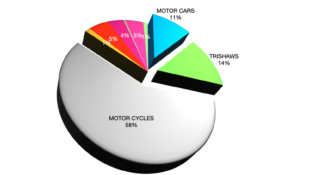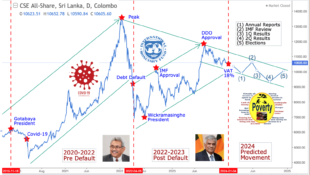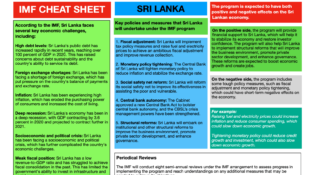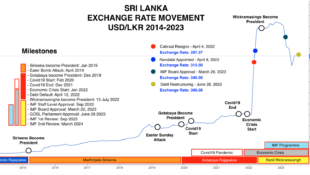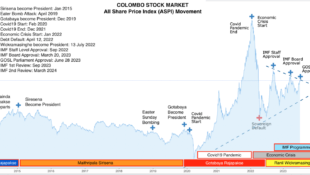Amid the COVID-19 pandemic, Sri Lanka’s economy contracted by 3.6 percent in 2020, the worst growth performance on record, as is the case in many countries fighting the pandemic. Swift measures enacted by the government in the second quarter helped contain the first wave of COVID-19 successfully, but these measures hit sectors like tourism, construction, and transport especially hard, while collapsing global demand impacted the textile industry. Job and earning losses disrupted private consumption and uncertainty impeded investment.
As a result, the economy contracted by 16.4 percent (y-o-y) in the second quarter. The economy began to recover in the third quarter as the first wave was brought under control and containment measures were relaxed. The momentum continued in the fourth quarter as the economy was broadly kept open despite a second wave of COVID-19 infections.
The government took proactive measures to mitigate the impact of the pandemic. Despite limited fiscal space, resources were allocated (approximately 0.7 percent of GDP) for health measures, cash transfers, and postponed tax payments. While public expenditures increased, revenues declined, re- sulting in a widening of the fiscal deficit in 2020. Due to the economic contraction and the elevated fiscal deficit amid COVID-19, public and publicly guaranteed debt is estimated to have increased to 109.7 percent of GDP. In line with the government strategy to reduce external debt over the medi- um-term, debt financing relied increasingly on domestic sources.
The Central Bank of Sri Lanka (CBSL) significantly contributed to the crisis response. It under- took considerable monetary policy easing, for which there was room given benign inflation, and additional measures to increase liquidity in the market and support businesses. It also introduced financial sector regulatory measures, like a debt moratorium for COVID-19 affected businesses and individuals. However, despite these efforts, bank lending to the private sector remained low. By contrast, credit to the government and state-owned enterprises surged and accounted for 80 percent of the total credit in 2020. The pandemic likely exacerbated pre-existing financial sector vulnerabil- ities, although the full impact of COVID-19 cannot yet be observed.
An improved trade balance and strong remittance inflows narrowed the current account deficit. A sharp drop in imports in 2020 more than offset the decline in exports. However, with financial inflows insufficient to meet external liabilities, reserves declined to an 11-year low in February 2021, before a currency swap worth US$ 1.5 billion with the People’s Bank of China was approved in March 2021. Due to a shortage of foreign currency, the exchange rate depreciated by 6.5 percent from January through March 17, 2021. The CBSL took several measures to preserve foreign ex- change reserves and reduce pressures on the exchange rate.
Outlook and Medium-term Prospects
Growth is expected to recover to 3.4 percent in 2021, mainly reflecting a base effect and FDI inflows. Gradually normalizing tourism and other economic activities as well as already signed investments will support growth. However, the subdued global recovery may dampen export demand. Over the medium-term, continued trade restrictions, economic scarring from the slowdown, and the high debt burden may weigh on growth prospects. Through an enhanced focus on an export-oriented growth model that taps the full potential of private investment, the country could realize its ambi- tions to increase its competitiveness and raise growth in a sustainable manner.
The forecast is subject to both upside and downside risks. If the global economy recovers faster than expected and the global tourism industry rebounds more quickly with the progress on vaccination pro- grams, the growth outlook could become more favorable. On the other hand, downward risks persist, pertaining to debt and external sustainability given high debt and low external buffers, especially because the repayment profile requires accessing financial markets frequently. Given large refinancing require- ments, constrained market access amid rating downgrades is a challenge. Thus, striking a balance between supporting the economy amid COVID-19 and ensuring fiscal sustainability is key. A reform program to provide a fiscal anchor could help Sri Lanka to reduce debt vulnerabilities and lower sovereign risk.
Special Section: The COVID-19 Impact on Employment and Poverty
The Special Focus section of this edition discusses the impact of COVID-19 on poverty. The eco- nomic contraction in the wake of COVID-19 has reversed past progress, at least temporarily. Pov- erty is expected to have risen since the onset of the pandemic mostly due to widespread job and earning losses. Simulations suggest that job losses were more likely to occur in urban areas and among private sector and own-account workers. Job losses were concentrated in the lower-middle of the income distribution: workers most vulnerable to job loss are located between the 20th and 40th percentiles of the pre-pandemic earnings distribution. Temporary absence from work and job losses occurred less frequently than declines in earnings. While informal workers are more likely to suffer earnings losses, formal workers have been affected as well, for example in the export-oriented apparel industry.
With jobs lost and earnings reduced, the $3.20 poverty rate is projected to have increased from 9.2 percent in 2019 to 11.7 percent in 2020. The poorest experienced the largest proportionate earnings shock while the smallest proportionate income losses were suffered by the richest.
The latter tend to have formal, secure jobs and better access to digital technology that allows them to conduct wage work or business operations remotely.
To mitigate the impact of the economic hardship on the poor and vulnerable, the government im- plemented several livelihood support programs, which helped to soften the labor market shock and the impact on poverty. Further progress in restoring livelihoods and making them more resilient could help Sri Lanka to continue its path of poverty reduction and shared prosperity. The current social protection system could support the reintegration of those who lost their jobs. In the medi- um term, social safety nets could be better targeted toward the poor and vulnerable, and adjusted to allow for support to be scaled up quickly and effectively in times of crises.
Unequal opportunities to work from home have introduced new economic and spatial divides as working remotely is nearly exclusively an option for high-income earners, and small and me- dium-sized enterprises were unlikely to adopt digital technologies. In the medium to long-term, digital technologies could become an important engine for job growth. However, despite widescale ownership of cellphones in Sri Lanka, the digital revolution will fall short of expectations without expansion of high-speed networks and accessible data on the whole island. Sri Lanka could provide new opportunities for economic mobility through policies that expand or universalize access to digital infrastructure. Investments in digital literacy are a prerequisite for widely shared benefits from these new opportunities.
Medium-term outlook
Growth should recover gradually in 2021. The economy is expected to grow by 3.4 percent in 2021, from a low base, as vaccination programs progress in Sri Lanka and its major trading partners. Already-signed investments into the Colombo Port City and Hambantota Industrial Zone and grad- ually normalizing domestic economic activities should provide an impetus to growth. However, the momentum of the recovery is expected to be constrained due to: (i) subdued export demand and tourism, as well as lower remittances growth amidst the sluggish global recovery and (ii) the chal- lenging domestic macroeconomic situation. Continued import restrictions and the high debt bur- den will adversely affect growth and poverty reduction over the medium-term.
Inflationary pres- sure is expected to materialize in 2021-2023 due to the partial monetization of large fiscal deficits.
External buffers are expected to remain low, with subdued financial inflows and significant financing needs. The current account deficit is projected to remain low in 2021, with strict import restrictions largely offsetting relatively low garment exports and tourism receipts. The currency swap with the People’s Bank of China and a remaining tranche of US$ 700 million from the China Development Bank will support reserves in 2021.
However, beyond 2021, significant additional borrowing will be required to close the external financing gap, with external public debt service requirements estimated at above US$ 4.0 billion each year between 2021 and 2023. Given high debt service obligations, the ratio of official reserves to short-term external liabilities is expected to deteriorate further. In the medium-term, mobilizing more non-debt creating sources of finance, for example foreign direct investment, will be important.
High fiscal deficits will further weaken debt sustainability. The fiscal deficit is projected to reach 9.4 percent of GDP in 2021 and to remain high in 2022 and 2023 (despite tightly controlled expen- ditures), as revenue collection is expected to remain weak due sluggish economic activity and the revenue measures enacted in 2019. As a result, PPG debt is expected to reach 115.0 percent of GDP in 2021 and to rise further in 2022 and 2023.
Risks and priorities
Downside risks to the outlook persist. The baseline assumes a quick and comprehensive vaccine rollout, in line with the government’s aims to vaccinate 60 percent of the population in 2021. Delays in the vaccination process in Sri Lanka and/or major tourist origin countries would extend the hori- zon and depth of economic disruptions. A longer downturn could push many SMEs from illiquidi- ty to insolvency. A simple simulation of the impacts of two scenarios on the global recovery, a more positive and a more adverse international recovery compared to the baseline, show a significant impact of global developments on Sri Lanka’s growth path, with growth projected at 4.6 percent in the former case, compared to only 2.0 percent in the latter (Figure 19).13 Lower growth would also put additional strain on public finance and could elevate risks to macroeconomic stability.
The amount of debt and its composition imply significant fiscal risks. Sri Lanka is highly sus- ceptible to market sentiments as its debt repayment profile requires the country to access financial markets frequently. Constrained market access amid rating downgrades remains a key challenge giv- en the large refinancing requirements. A higher than expected deficit or lower than expected GDP growth could further affect market sentiments.14 A simple simulation of an adverse fiscal scenario shows that the economy could contract further in 2021 (Figure 19).15 Thus, striking a balance be- tween supporting the economy amid COVID-19 and ensuring fiscal sustainability is key. A reform program to provide a fiscal anchor could help reduce debt vulnerabilities and lower sovereign risk.
In the medium-term, Sri Lanka needs to improve its competitiveness to raise growth. As a rel- atively small but strategically located country, Sri Lanka could strive to achieve sustainable develop- ment by moving towards an export-oriented and private-investment led growth model.
This would likely require promoting trade and private investment (including FDI), establishing the necessary conditions for a thriving knowledge economy, facilitating public-private partnerships in key sectors (such as in infrastructure, health, and tourism), investing in tourism infrastructure, allowing pro- ductive local companies to integrate into global value chains, and attaining higher value addition in the manufacturing, agribusinesses, and service sectors.
Read World Bank Full Report:
https://thedocs.worldbank.org/en/doc/15b8de0edd4f39cc7a82b7aff8430576-0310062021/original/SriLanka-DevUpd-Apr9.pdf
 would enable you to enjoy an array of other services such as Member Rankings, User Groups, Own Posts & Profile, Exclusive Research, Live Chat Box etc..
would enable you to enjoy an array of other services such as Member Rankings, User Groups, Own Posts & Profile, Exclusive Research, Live Chat Box etc.. 
 Home
Home












